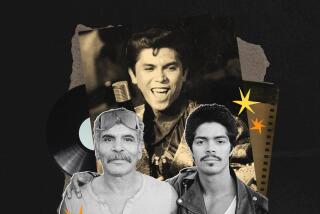The ‘Story’ Behind the Music of Ritchie Valens
- Share via
“I first heard about Richard Valenzuela from a young man who was preparing my new business cards for Del-Fi Records. . . . May, 1958.”
That’s part of the opening reminiscence on a new album produced by Bob Keane, the Los Angeles record-maker who signed and recorded the teen-ager who later shortened his name to Ritchie Valens and became part of rock history thanks to such hits as “Donna” and “La Bamba.”
Keane’s reflections are the focus of “The Ritchie Valens Story,” a warm, endearing album being released through Rhino Records to tie into the arrival this week of a Valens commemorative stamp--part of the U.S. Postal Service’s “Legends of American Music” series.
Though the new album contains the hit versions of “Donna,” “La Bamba” and “Come On, Let’s Go,” it’s not the definitive collection of Valens’ music. The formal Valens music collection is “The Best of Ritchie Valens” on Rhino. This is the story behind the music, including previously unreleased demo tapes recorded in Keane’s home.
Continuing his tale about how he discovered the singer, who was killed in a 1959 plane crash with Buddy Holly and the Big Bopper, Keane says the young man with the business cards described Valens as “the Little Richard of San Fernando.”
Keane was intrigued enough to go see Valens sing at a movie theater before a Saturday matinee. Impressed, he invited Valens to his house, where they recorded a ragged, Buddy Holly-influenced version of his song “Come On, Let’s Go.” Keane then took Valens into Hollywood’s famed Gold Star studio and recorded the song, which became a Top 50 hit in the summer of 1958.
While Keane was driving Valens to San Francisco for a TV appearance to promote the hit, Valens started playing an old Mexican folk song on the guitar . . . “La Bamba.”
“I felt it would make a good Latin rock song,” Keane explains in the narration. “But Ritchie didn’t know the words and he didn’t want to record it anyway. He felt it might demean the music of his heritage.”
Valens later changed his mind. He learned the words from his aunt and recorded the song at Gold Star. The album contains the lively hit version, plus the instrumental track without the vocal.
The 61-minute album also features a radio promotional announcement for the “Winter Dance Party,” the national tour that Valens was on when killed in the crash in Iowa.
“Hi, everybody, this is Ritchie Valens,” the promo went. “I’ll be on the ‘Winter Dance Party’ coming your way very shortly. I will be having a ball singing for you and I hope to see you real soon. By the way, I hope you have been hearing a lot of my latest Del-Fi release . . . ‘La Bamba’ and ‘Donna.’ ” Valens’ voice is followed by a radio report of the plane crash.
Also in the racks:
* Chris Montez’s “Let’s Dance: All-Time Greatest Hits” on DCC Compact Classics. Montez, who was raised in Hawthorne, was one of many Latino musicians inspired by Valens’ success (he’s part of the “Latin Rock & Soul” bill at the Greek Theatre on June 27). This 1991 release contains all seven of his hit singles, including 1962’s “Let’s Dance” and 1966’s “The More I See You” (48 minutes, liner notes).
More to Read
The biggest entertainment stories
Get our big stories about Hollywood, film, television, music, arts, culture and more right in your inbox as soon as they publish.
You may occasionally receive promotional content from the Los Angeles Times.









